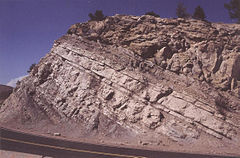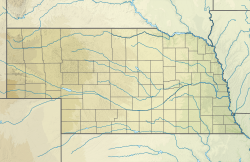The Dakota is a sedimentary geologic unit name of formation and group rank in Midwestern North America. The Dakota units are generally composed of sandstones, mudstones, clays, and shales deposited in the Mid-Cretaceous opening of the Western Interior Seaway.[7] The usage of the name Dakota for this particular Albian-Cenomanian strata is exceptionally widespread; from British Columbia and Alberta to Montana and Wisconsin to Colorado and Kansas to Utah and Arizona. It is famous for producing massive colorful rock formations in the Rocky Mountains and the Great Plains of the United States, and for preserving both dinosaur footprints and early deciduous tree leaves.
Owing to extensive weathering of older rocks during the Jurassic and Triassic, the Dakota strata lie unconformably atop many different formations ranging in age from Precambrian to Early Cretaceous. With a few local exceptions, it is the oldest Cretaceous unit exposed in the northern Great Plains, including Kansas, Nebraska, Iowa, Minnesota, and Wisconsin, as well as the Desert Southwest. It generally consists of sandy, shallow marine or beach deposits with marine-influenced mudflat sediments, and occasional stream deposits.[8][9]
- ^ "Geologic Unit: Woodbury". National Geologic Database. Geolex — Significant Publications. United States Geological Survey. Retrieved November 27, 2020.
- ^ Cite error: The named reference
AZtoOKwas invoked but never defined (see the help page). - ^ Edward Murphy, editor, North Dakota Stratigraphic Column, North Dakota Geological Surve.
- ^ a b Cite error: The named reference
GeolexDakotawas invoked but never defined (see the help page). - ^ Cite error: The named reference
Ludvigson2010was invoked but never defined (see the help page). - ^ Cite error: The named reference
meekandhayden1862was invoked but never defined (see the help page). - ^ Monroe, James S. and Wicander, Reed (1997) The Changing Earth: Exploring Geology and Evolution (2nd edition) Wadsworth Publishing Company, Belmont, California, page 610, ISBN 0-314-09577-2
- ^ "Geology of the Quarry: Dakota Sandstone" Dinosaur National Monument, National Park Service
- ^ McLaughlin, Thad G. (1942) "Water-bearing Formations, continued: Cretaceous System: Dakota Group" Geology and Ground-Water Resources of Morton County, Kansas



